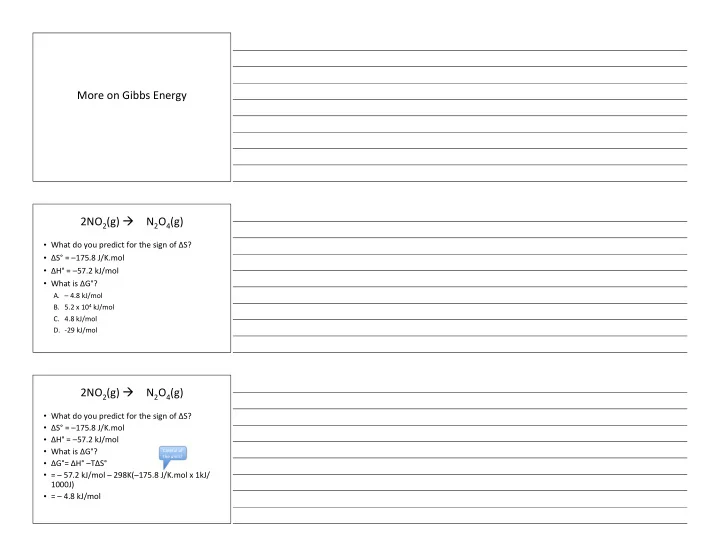

More ¡on ¡Gibbs ¡Energy 2NO 2 (g) ¡ à N 2 O 4 (g) • What ¡do ¡you ¡predict ¡for ¡the ¡sign ¡of ¡ΔS? • ΔS° ¡= ¡–175.8 ¡J/K.mol • ΔH° ¡= ¡–57.2 ¡kJ/mol • What ¡is ¡ΔG°? A. – ¡4.8 ¡kJ/mol B. 5.2 ¡x ¡10 4 ¡kJ/mol C. 4.8 ¡kJ/mol D. -‑29 ¡kJ/mol 2NO 2 (g) ¡ à N 2 O 4 (g) • What ¡do ¡you ¡predict ¡for ¡the ¡sign ¡of ¡ΔS? • ΔS° ¡= ¡–175.8 ¡J/K.mol • ΔH° ¡= ¡–57.2 ¡kJ/mol • What ¡is ¡ΔG°? Careful ¡of ¡ the ¡units! • ΔG°= ¡ΔH° ¡–TΔS° • = ¡– ¡57.2 ¡kJ/mol ¡– ¡298K(–175.8 ¡J/K.mol ¡x ¡1kJ/ 1000J) • = ¡– ¡4.8 ¡kJ/mol
At ¡what ¡temperature ¡will ¡the ¡reacZon ¡ • When ¡ΔG°= ¡0 When ¡ΔG ¡=0 ¡ • The ¡system ¡is ¡at ¡ equilibrium – (for ¡example ¡a ¡phase ¡change) • So ¡ΔG ¡= ¡ΔH ¡– ¡TΔS ¡becomes • 0 ¡= ¡ΔH ¡– ¡TΔS ¡ • ΔH ¡= ¡TΔS ¡ • For ¡water ¡boiling ¡ΔH° ¡= ¡40.65 ¡kJ/mol • What ¡is ¡ΔS°? • ΔS° ¡= ¡109 ¡J/K.mol C 6 H 12 O 6 (s) ¡+ ¡6 ¡O 2 (g) ¡ ¡ ➞ ¡ ¡6 ¡CO 2 (g) ¡+ ¡6 ¡H 2 O(g) This ¡is ¡a ¡combusZon ¡reacZon: ¡what ¡do ¡you ¡ predict ¡the ¡sign ¡of ¡enthalpy ¡change ¡will ¡ΔH ¡be? A. + B. – C. 0 D. Don’t ¡know What ¡about ¡ΔS? ¡ΔG? ¡
C 6 H 12 O 6 (s) ¡+ ¡6 ¡O 2 (g) ¡ ¡ ➞ ¡ ¡6 ¡CO 2 (g) ¡+ ¡6 ¡H 2 O(g) ΔH ¡is ¡–, ¡ΔS ¡is ¡+, ¡and ¡ΔG ¡is ¡– ¡(at ¡all ¡ temperatures) ¡ This ¡reacZon ¡is ¡always ¡favorable! 6 ¡CO 2 (g) ¡+ ¡6 ¡H 2 O(g) ¡ ➞ ¡C 6 H 12 O 6 (s) ¡+ ¡6 ¡O 2 (g) ΔH ¡is ¡+, ¡ΔS ¡is ¡–, ¡and ¡ΔG ¡is ¡+ ¡(at ¡all ¡ temperatures) ¡ This ¡reacZon ¡is ¡NEVER ¡favorable! But ¡it ¡happens ¡– ¡(how?) From ¡the ¡ sun “captured ¡energy” ¡+ ¡ ¡6 ¡CO 2 (g) ¡+ ¡6 ¡H 2 O(g) ¡ Dissipated ¡as ¡ “heat” ¡not ¡ useful
As ¡we ¡will ¡see ¡next ¡semester, ¡the ¡ CalculaZng ¡ΔH°, ¡ΔS°, ¡and ¡ΔG° ¡from ¡ standard ¡thermodynamic ¡formaZon ¡data. • There ¡are ¡tables ¡of ¡these ¡values ¡that ¡can ¡be ¡ used ¡to ¡calculate ¡overall ¡changes ¡for ¡a ¡reacZon • ΔH° f ¡(standard ¡heat ¡of ¡formaZon) ¡ – Enthalpy ¡change ¡when ¡a ¡substance ¡is ¡formed ¡from ¡ its ¡elements ¡in ¡their ¡standard ¡states. • For ¡any ¡reacZon • ΔH° f ¡=ΣΔH° f ¡products ¡– ¡Σ ¡ΔH° f ¡reactants 6 ¡CO 2 (g) ¡+ ¡6 ¡H 2 O(g) ¡ ➞ ¡C 6 H 12 O 6 (s) ¡+ ¡6 ¡O 2 (g) • ΔH° f ¡ ¡for: • CO 2 (g) ¡= ¡– ¡394 ¡kJ/mol • H 2 O(g) ¡= ¡– ¡242 ¡kJ/mol • C 6 H 12 O 6 (s) ¡= ¡-‑1271 ¡kJ/mol • ¡O 2 (g) ¡= ¡0 ¡kJ/mol ¡(element ¡in ¡its ¡standard ¡state)
Third ¡Law ¡of ¡Thermodynamics • The ¡entropy ¡of ¡a ¡perfect ¡crystal ¡at ¡0K ¡is ¡0 • This ¡allows ¡us ¡to ¡calculate ¡actual ¡entropies ¡of ¡ materials ¡(as ¡opposed ¡to ¡changes ¡in ¡entropy) • S° ¡H 2 O(l) ¡= ¡69.9 ¡J/K.mol, ¡H 2 O(g) ¡= ¡189 ¡J/K.mol • And ¡ • ΔS° r ¡=ΣS° ¡products ¡– ¡ΣS° ¡reactants ¡
Recommend
More recommend